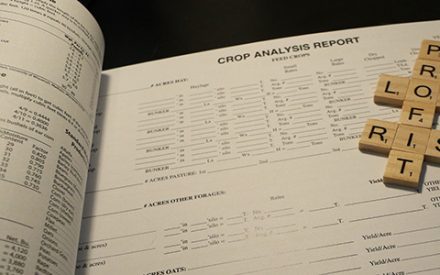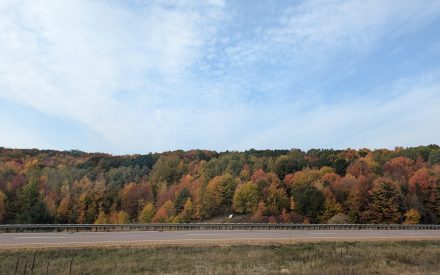Video Summary
In this video, Hava Blair, researcher, UW–Madison Department of Soil and Environmental Sciences, presents an in-depth overview of the Wisconsin Phosphorus Index (P Index), a modeling tool used to estimate phosphorus runoff from agricultural fields to nearby surface waters. Integrated into the SNAPPlus nutrient management planning software, the P Index helps farmers, agronomists, and conservation professionals assess phosphorus loss risk based on field management practices, soil characteristics, and landscape features.
Hava explains how the model works, recent updates, and how it supports nutrient planning, conservation efforts, and water quality protection. The presentation also highlights how the model is validated using real-world data and used in various decision-support tools across Wisconsin.
Resources
Transcript
0:05
OK, that sounds great.
0:06
Thank you, Chris.
0:06
Hi, everybody.
0:07
I’m excited to be here today.
0:08
And I, I think that everything that Kelsey and Laura just shared, I feel like it really queued us up for this last part of the presentation because there’s a lot of really natural connections between what I’m going to talk about with the Wisconsin phosphorus index model and a lot of the same processes and and risk factors that Kelsey and Laura mentioned.
0:25
So I’ll just kick off today saying with an explanation of what is the Wisconsin phosphorus index.
0:31
So this may not be something that you’ve heard of before.
0:34
It’s a model that estimates phosphorus delivery from a field to the nearest surface water.
0:40
So I have this very stylized diagram here showing that we have a field and the Wisconsin P index is concerned, again just with surface runoff.
0:49
So we’re not, we don’t have a component of the model of dealing with tile and any potential losses into tile, but we’re looking at runoff from a field and then that travels through the landscape and reaches the nearest surface water.
1:01
So our goal is to use what we know about the management practices on that field and the soil and many other factors to try to get an idea of how much phosphorus might be lost in different situations.
1:14
And even if you haven’t heard of the Wisconsin P Index, it’s possible that you have heard of SNAP Plus or the Soil Nutrient Application Planner Plus, which is the nutrient management planning software that our team builds here at the UW.
1:28
So we have been around for about 20 years now going through different versions of the software and continuing to evolve it.
1:34
And we’re really grateful for support from DNR and DATCP and NRCS that allow us to do this.
1:40
And then also help from Extension to help get the word out about this too, to help manage nutrients.
1:46
And for the focus today, think about how we identify the best places to put phosphorus so that we’re not losing it and at less of a risk of losing it.
1:56
So I want to start with what what this actually looks like, what the most people’s user, user experience I would say who are using Snap Plus to write a nutrient management plan.
2:07
What are they seeing with this phosphorus index model?
2:10
So the phosphorus index is integrated into the SNAP Plus software and it’s actually a result that you would see after you enter your crop information and your nutrient application information and soil information into the program.
2:25
So I’m showing here just the very start of the screen that you would work with in Snap Plus, and then we’ll zoom in so that you can kind of see some of the information that we’re working with here.
2:35
So because this is a program that is used for writing nutrient management plans, the type of information that you’re putting into the program is information about the crop, the expected yield, the tillage.
2:48
And then we have all this information about nutrients.
2:51
And I want to call your attention to 2 results here.
2:53
We have the phosphorus index calculation shows up on the right side here as an average value across a rotation.
3:01
And then we also have information about any given year, the phosphorus index, which would again be that total pounds of phosphorus delivered to surface water per acre per year.
3:13
So that’s what those numbers are representing down there.
3:16
And what I want to do today in this presentation is take you behind the scenes and give you an idea of how does this work?
3:23
You know, how do we account for these different field management practices, different amounts of phosphorus inputs from manure and fertilizer, and the diversity of soil and slope conditions that we know are really important when we think about where are we losing phosphorus on the landscape.
3:38
So I’m going to kind of peel back the curtain here and hopefully give you an idea of how we do these calculations and what kind of data research this is all based on.
3:47
So phosphorus management is a key component of the 590 nutrient management planning standard.
3:53
So if you’re in the nutrient management planning world, you’ve probably heard about the 590 standard before.
3:59
And here I’m highlighting a section of it that describes A requirement to use some sort of phosphorus management strategy as a way to identify places that you can place manure to minimize its impact on water quality.
4:13
So this conversation around P index or P indices all across the United States actually started in the early 2000s when there was more of a mandate from the NRCS to start managing phosphorus in this way and considering potential impacts.
4:29
And Wisconsin went ahead and developed this Wisconsin phosphorus index model in response to some of these concerns as an assessment tool, as a way to figure out how can we identify places that might be fields that might be at high risk of phosphorus loss and what can we do in terms of management to try to mitigate that.
4:49
And in terms of who’s actually using SNAP Plus, of course, people who are writing nutrient management plans utilize this tool in this model.
4:56
But I also want to highlight that having a model like this is useful for a lot of other different types of groups.
5:02
So we have farmer led watershed groups and water quality projects that use this model to try to understand the impact of different practices on phosphorus loss.
5:13
It’s used by the DNR.
5:14
It’s been proposed to be used by a couple nonprofit organizations that are exploring pay for performance conservation in agricultural fields.
5:23
And then it’s also been integrated into some decision support tools.
5:27
So other web applications built here at the UW called Grayscape and Smartscape that are looking at getting more pasture and perennial grassland out on the landscape.
5:37
And what is the impact of that on phosphorus loss.
5:39
So having a tool like this and a model that lets us account for all these different important variables that impact phosphorus loss has uses across a lot of different scenarios that I think are are relevant to the work that that we do.
5:54
So digging more and a little bit into the model and what are we actually calculating and estimating here?
6:00
I’ll break it down into a couple different pieces.
6:02
So starting at the field level, we know that runoff carries dissolved and sediment bound or particulate phosphorus.
6:08
So Kelsey and Laura gave gave that great intro to these different pools of phosphorus that we can talk about.
6:15
And then we know once that phosphorus gets to the edge of the field, then there are also some really important processes to consider about how much of that is actually delivered from the field to the nearest surface water.
6:28
So here I’m showing this landscape to illustrate that we know that when you have water moving across the landscape, some of the some of the eroded soil might settle out, You might have some different transformations of phosphorus into different forms.
6:42
So this is something that our phosphorus index model considers too, this the delivery component of this.
6:50
So one thing I want to start as sort of a scaffold is to help you understand that one of the important constraints that we have with the Wisconsin phosphorus index model is we want to use inputs and data that are already part of a nutrient management plan.
7:08
So people are writing nutrient management plans and we know information about crop and rotation and nutrient applications and soils.
7:15
And so this model is set up to avoid extra data entry, right?
7:20
Avoid extra stuff.
7:20
Try to use what we data that we know isn’t available to people that they’re already needing to enter to do their planning, and then use that as part of this assessment process.
7:30
And the modelling.
7:31
And what we’re doing here is big picture.
7:34
We’re trying to account for what we know are the different sources of phosphorus and how it’s transported.
7:41
And because we’re doing this in the context of nutrient management planning, which is forward-looking, you know we don’t know the weather that’s going to come next crop year or the year after.
7:50
We’re also using data about long term average weather trends.
7:53
So when I talk about, you know, results from the phosphorus index and these estimates of the amount of annual phosphorus that might be leaving a field, keep in mind that we’re talking about numbers that are average weather values because that’s the kind of data that we have available to use in this planning context.
8:13
And before I go any further, I want to give a shout out to the many different contributors to the phosphorus index over the years.
8:19
So I happen to be the current maintainer and caretaker of the model, but the research has benefited from a lot of different people that are listed on this slide and a lot of different data coming from all around Wisconsin that helps us test this model and improve it and do a better job actually representing real Wisconsin agricultural systems.
8:38
So I won’t read every name on the slide and I’m sure there are people that that I forgot, but I just want to make sure everybody understands that this has been an evolving effort and something that we continue to try to improve with additional data and additional insights.
8:52
So if we dig in a little further here and and think about how is this phosphorus index actually calculated, I’ll walk you through each of these different pieces.
9:00
So I mentioned that we’re considering from the field a sediment or a particulate phosphorus, and then we’re also interested in dissolved phosphorus from a few different sources.
9:11
So we know that the soil itself is a source of phosphorus.
9:15
We were just talking about soil test P But then we also know that through amendments or through nutrients like manure and fertilizer, those are also contributing some amount of phosphorus to the system.
9:25
So we want to capture all of those different sources.
9:29
After we have that and we’ve estimated how much phosphorus is making it to the edge of the field, then the next component is considering the delivery, which is what I was describing across the landscape here.
9:39
So that’s a way to account for the fact that some fields are located right next to a Little River or stream and some fields are very far away.
9:47
And we want to make sure we’re accounting for the fact that the amount of risk, you know, the amount of water quality risk from comparing those two fields is not equal.
9:55
And we want to address that with this delivery ratio where we take the result of how much phosphorus we estimate might be making it to the edge of the field and we adjust that based on the slope to the nearest surface water and the distance to the nearest surface water.
10:11
And then when we consider those two boxes together, that is what makes up that final number that I showed in some of the earlier slides of that result for the rotational average P delivery to surface water.
10:23
That’s what we call the P index result.
10:27
So if we can briefly, I’m going to just show some equations and just walk you through the high level how this is calculated because I think it’ll it’ll make a lot of sense based on what we’ve learned so far about phosphorus and soil test P and we’ll start with this particulate or sediment bound portion.
10:41
So here the two big parts of the equation that we’re thinking about is how much sediment or soil is leaving the field, which is in purple here.
10:49
And then what is the amount of phosphorus or the concentration in that sediment.
10:53
And those two things together give us an idea of the mass of phosphorus that’s moving with this sediment.
11:00
And so to get at that first part of of like how much phosphorus is there, we are using information from standard agronomic soil tests that are required As for nutrient management planning.
11:11
And what we do is we calculate this adjusted surface soil test phosphorus and then or we use the surface soil test phosphorus and the organic matter to estimate a soil total phosphorus.
11:22
And one important part of this that touches on Kelsey and Laura’s work is that we do account for stratification in different types of tillage systems here because we recognize exactly like their data showed that you can have a concentration of phosphorus in the surface there that is very subject to interaction with water.
11:40
And if that is the sediment that’s leaving the field, it’s got, it’s pretty hot, it’s got a lot of phosphorus in it.
11:46
And then the other piece that’s important to understand here when we think about sediment is we know we break down the sand and silt and clay and different particle size classes.
11:57
Those have different phosphorus content too.
11:59
So the smaller, typically the smaller classes like clay and silt are enriched in phosphorus.
12:05
So we account for that in the model.
12:08
And then to estimate erosion, we’re using Russell 2, which is the revised universal soil loss Equation 2 might be familiar to some of you if you’ve taken soil’s classes.
12:18
And that’s how we’re able to get an estimate of these different size fractions for particles.
12:23
Looking at the dissolved phosphorus portion of this, again, we’re thinking about soil, manure and fertilizer contributions and how much of those things are being dissolved in runoff water that’s moving off this field.
12:37
So I’ll keep it high level here with the equations.
12:40
But the thing to note about this is that each of these equations has two parts.
12:45
One part is about the runoff and one part is about the amount of phosphorus that can be dissolved from each of these sources.
12:53
So we’ve got the soil, we’ve got the manure and we’ve got the fertilizer.
12:58
So the exact form of these equations is not, is not super important, but I just want you to have the sense that there are these two parts that we need to consider.
13:05
So the amount of runoff and then how much phosphorus is actually there to get dissolved, We get to this point of calculating runoff using a method called a curve number method.
13:16
And again, we’re using precipitation data that’s average for each county across 20 years.
13:22
And that’s what allows us to make these estimates for how much phosphorus might be leaving the field combined with what we know about manure applications.
13:30
So how much manure went out, how much fertilizer went out?
13:33
And we can calculate the amount of phosphorus based on that.
13:38
And that star I wanted to mention the star is there because we have a new method for calculating winter runoff and that’s part of the recent updates to Snap Plus.
13:47
One other new thing that I want to mention that this gets at how we’re able to dial this model in for different types of management practices is that we now account for different tillage systems and the way that they mix the soil and they might be burying phosphorus below the surface to a different extent.
14:06
So here I’m just showing a table that has numbers showing what is the fraction of phosphorus that was applied to the surface and how much of that remains after different types of tillage or incorporation passes.
14:19
And finally, this last piece that I want to talk about before we zoom out and do a summary is that is that delivery ratio that I was mentioning.
14:26
And so this is the factor that we apply to account for the fact that fields are sometimes different distances from surface water and different slopes.
14:36
And it’s a way for us to get at how much phosphorus is actually making it there to the edge to the surface water.
14:43
Now I’ve gone through and I’ve described a number of recent updates to the phosphorus index and this is the high level.
14:49
When we change the model, of course, that changes the results that are important.
14:53
Part of nutrient management planning is people are keeping track of their average phosphorus index.
14:57
So these changes are mostly going to be dependent on the specific situation.
15:03
But we can note that winter runoff calculation changes will be variable depending on county precipitation levels.
15:11
With the phosphorus enrichment ratios that we updated, that is generally going to have particulate phosphorus estimates going up because of the silt fraction that is getting a different enrichment.
15:22
And then finally that table I showed of different tillage and the fraction of phosphorus that stays on the surface from tillage, That’ll also depend on what specific tillage system people are using.
15:33
But luckily in our updated version, we’re able to be more specific about those different operations and, and what that impact is.
15:40
So I want to close by saying that I’ve described these equations to you.
15:43
I’ve walked you through these different pieces.
15:45
And then the last thing I want to share is that when we do this work, we’re testing all of these equations against field monitoring data, against measured data that is being collected by a lot of different groups, including Discovery Farms and Pioneer farms and the ag research stations to help help us understand are we actually doing a good job representing these important processes and variables.
16:07
So what I’m showing here is some data from one study where we did some testing across 86 site years to see how well the Wisconsin P index equations are able to represent phosphorus loss compared to measured values.
16:20
So in when we’re looking at this graph of total P, we’ve got the measured phosphorus at on the X axis here on the horizontal.
16:28
And then we’ve got the Wisconsin P index predictions or estimates on the Y axis.
16:34
And what we’re always looking for here is opportunities or situations, whether it’s specific tillage systems or cropping systems, where maybe the model is not doing a good job.
16:44
And what we’re measuring is very different from what we’re modeling.
16:46
And we try to dig into that and identify updates to the model like the ones that I’ve described so that we can do a better job with those.
16:55
And I would say that just to bring this back to I think some of the comments that Laura was making at the end of her presentation, one of the nice things about having a model like this that allows us to estimate different types of phosphorus loss is we can do these sort of what if scenarios.
17:12
You know, we can look at different types of management, different manure application rates and methods, different tillage, and we can understand how different fractions of phosphorus might be lost from these different management decisions on a given field with a given soil and slope.
17:29
So here I’m showing some examples that illustrate a 1 fall chisel scenario and two no till scenarios with different manure timings and application methods.
17:40
And the, I see we’re getting close to time.
17:43
So I’ll just leave this big picture as saying here, we can see that we have different fractions of phosphorus lost based on these different types of, of application scenarios.
17:52
And that can be an interesting way to understand some of the different processes at play here and help us think about what we can do to, to mitigate those losses.
18:01
So I’ll, I’ll end with this slide.
18:03
And I know that my contact info is probably already in the chat or will be soon.
18:07
And I’m happy to take questions in e-mail or here about Snap Plus or the P index.
18:13
Thank you.
18:13
Yeah, excellent, Hava, an excellent presentation.
18:16
And I think that both of these presentations today maybe bring up some really good conversation and talking points as agronomists and farmers hear these things and they think about their practices as well as thinking about like Josh was telling us, we’ve got flood warnings and there’s going to be some potential for soil leaving fields.
18:39
And farmers are always trying to look about what can they do better.
18:42
And I think this is a great tool that we have in our state to help protect water quality.
Badger Crop Connect
Timely Crop Updates for Wisconsin
Second and fourth Thursdays 12:30 – 1:30 p.m.
Live via Zoom

 ▶ Fall 2025 Financial Assistance for Producers
▶ Fall 2025 Financial Assistance for Producers ▶ Fall 2025 Ag Policy Update
▶ Fall 2025 Ag Policy Update ▶ Fall 2025 Corn and Soybean Market Outlook
▶ Fall 2025 Corn and Soybean Market Outlook ▶ November 6 Ag Weather Outlook for Wisconsin
▶ November 6 Ag Weather Outlook for Wisconsin


